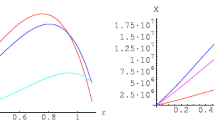Abstract
We consider the classical equations of motion for a single Galileon field with generic parameters in the presence of non-relativistic sources. We introduce the concept of absolute stability of a theory: if one can show that a field at a single point — like infinity for instance — in spacetime is stable, then stability of the field over the rest of spacetime is guaranteed for any positive energy source configuration. The Dvali-Gabadadze-Porrati (DGP) model is stable in this manner, and previous studies of spherically symmetric solutions suggest that certain classes of the single field Galileon (of which the DGP model is a subclass) may have this property as well. We find, however, that when general solutions are considered this is not the case. In fact, when considering generic solutions there are no choices of free parameters in the Galileon theory that will lead to absolute stability except the DGP choice. Our analysis indicates that the DGP model is an exceptional choice among the large class of possible single field Galileon theories. This implies that if general solutions (non-spherically symmetric) exist they may be unstable. Given astrophysical motivation for the Galileon, further investigation into these unstable solutions may prove fruitful.
Similar content being viewed by others
References
A. Nicolis, R. Rattazzi and E. Trincherini, The Galileon as a local modification of gravity, Phys. Rev. D 79 (2009) 064036 [arXiv:0811.2197] [INSPIRE].
F.P. Silva and K. Koyama, Self-accelerating universe in Galileon cosmology, Phys. Rev. D 80 (2009) 121301 [arXiv:0909.4538] [INSPIRE].
T. Kobayashi, Cosmic expansion and growth histories in Galileon scalar-tensor models of dark energy, Phys. Rev. D 81 (2010) 103533 [arXiv:1003.3281] [INSPIRE].
A. De Felice and S. Tsujikawa, Cosmology of a covariant Galileon field, Phys. Rev. Lett. 105 (2010) 111301 [arXiv:1007.2700] [INSPIRE].
N. Chow and J. Khoury, Galileon cosmology, Phys. Rev. D 80 (2009) 024037 [arXiv:0905.1325] [INSPIRE].
N. Agarwal, R. Bean, J. Khoury and M. Trodden, Cascading cosmology, Phys. Rev. D 81 (2010) 084020 [arXiv:0912.3798] [INSPIRE].
R. Gannouji and M. Sami, Galileon gravity and its relevance to late time cosmic acceleration, Phys. Rev. D 82 (2010) 024011 [arXiv:1004.2808] [INSPIRE].
C. Deffayet, G. Esposito-Farese and A. Vikman, Covariant Galileon, Phys. Rev. D 79 (2009) 084003 [arXiv:0901.1314] [INSPIRE].
C. Deffayet, S. Deser and G. Esposito-Farese, Generalized Galileons: All scalar models whose curved background extensions maintain second-order field equations and stress-tensors, Phys. Rev. D 80 (2009) 064015 [arXiv:0906.1967] [INSPIRE].
P. Creminelli, A. Nicolis and E. Trincherini, Galilean genesis: an alternative to inflation, JCAP 11 (2010) 021 [arXiv:1007.0027] [INSPIRE].
G. Dvali, G. Gabadadze and M. Porrati, 4D gravity on a brane in 5D Minkowski space, Phys. Lett. B 485 (2000) 208 [hep-th/0005016] [INSPIRE].
M.A. Luty, M. Porrati and R. Rattazzi, Strong interactions and stability in the DGP model, JHEP 09 (2003) 029 [hep-th/0303116] [INSPIRE].
C. de Rham and G. Gabadadze, Selftuned massive spin-2, Phys. Lett. B 693 (2010) 334 [arXiv:1006.4367] [INSPIRE].
J. Khoury, J.-L. Lehners and B.A. Ovrut, Supersymmetric Galileons, Phys. Rev. D 84 (2011) 043521 [arXiv:1103.0003] [INSPIRE].
K. Hinterbichler, M. Trodden and D. Wesley, Multi-field galileons and higher co-dimension branes, Phys. Rev. D 82 (2010) 124018 [arXiv:1008.1305] [INSPIRE].
C. Deffayet, S. Deser and G. Esposito-Farese, Arbitrary p-form Galileons, Phys. Rev. D 82 (2010) 061501 [arXiv:1007.5278] [INSPIRE].
A. Nicolis and R. Rattazzi, Classical and quantum consistency of the DGP model, JHEP 06 (2004) 059 [hep-th/0404159] [INSPIRE].
S. Endlich, K. Hinterbichler, L. Hui, A. Nicolis and J. Wang, Derrick’s theorem beyond a potential, JHEP 05 (2011) 073 [arXiv:1002.4873] [INSPIRE].
Author information
Authors and Affiliations
Corresponding author
Additional information
ArXiv ePrint: 1106.1659
Rights and permissions
About this article
Cite this article
Endlich, S., Wang, J. Classical stability of the Galileon. J. High Energ. Phys. 2011, 65 (2011). https://doi.org/10.1007/JHEP11(2011)065
Received:
Accepted:
Published:
DOI: https://doi.org/10.1007/JHEP11(2011)065




